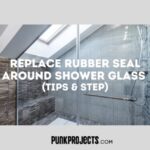Replace rubber seal around shower glass is no small task. This plays a major role in keeping water out and ensuring your bathroom stays dry. A sealed shower prevents leaks and water damage, plus it looks nice! Here’s what you need to know for replacing the rubber seal.
- Gather the tools and materials: utility knife, adhesive/sealant, and a new rubber seal strip. Clean the area first.
- Time to start: remove the old seal carefully with the knife. Be careful not to damage the glass or tiles. Clean any remaining adhesive or debris.
- Now it’s time to seal: Apply a thin layer of adhesive/sealant along one side of the new rubber seal strip. Press firmly against the glass and hold it in place. Gradually work your way around each side of the shower glass.
- You can now enjoy a dry bathroom. Check the seals regularly for any signs of wear. Replace them when needed.
Understanding the importance of replacing the rubber seal around shower glass

Replacing the rubber seal around shower glass alternatives is imperative for the function and look of your bathroom. Ignoring this detail can lead to water leakage and mold growth. Consider these points to understand why it’s so important:
- Waterproofing: The rubber seal is a barrier that stops water from getting through the gaps between the glass and other shower parts. Over time, these seals can get worn-out or damaged, weakening their ability to create a watertight seal. Replacing them ensures your shower stays waterproof, stopping potential water damage.
- Mold Prevention: When water leaks due to weak rubber seals, it can create a great place for mold growth. This not only looks bad, it also poses health risks. Replacing the seal helps avoid potential breeding grounds for mold, keeping your bathroom hygienic.
- Energy Efficiency: A lesser known perk of replacing rubber seals is improved energy efficiency. A sealed shower stops cold air entering and warm air escaping, lessening the burden on your heating system. This reduces energy usage and lowers bills.
Regular maintenance may not be enough for long-term protection. Replacing the rubber seal when signs of wear appear keeps you one step ahead of any potential problems.
Don’t ignore the importance of replacing the rubber seal around your shower glass; inspect them periodically and replace them when needed for a safe, healthy, and aesthetically pleasing bathroom.
Steps to replace the rubber seal around shower glass
Replacing the rubber seal around shower glass is a simple and necessary task to maintain the functionality and appearance of your shower. Follow these four steps to complete the replacement process:
- Remove the old seal: Start by carefully peeling off the old rubber seal from the shower glass. Use a putty knife or a similar tool to gently lift the seal and avoid damaging the glass surface.
- Clean the area: Thoroughly clean the area where the old seal was removed. Use a mild detergent or vinegar solution to remove any dirt, grime, or adhesive residue. Make sure the surface is completely dry before proceeding to the next step.
- Cut and attach the new seal: Measure the length of the shower glass and cut the new rubber seal accordingly. Apply a small amount of adhesive to one end of the seal and press it firmly onto the glass, starting from the bottom corner. Slowly work your way along the edge, pressing the seal tightly against the glass as you go.
- Allow time for drying: Once the new seal is attached, let it dry for the recommended time mentioned on the adhesive packaging. Avoid using the shower during this drying period to ensure a secure bond is formed.
Remember, replacing the rubber seal around your shower glass not only prevents leaks and water damage but also improves the overall hygiene and appearance of your bathroom. Don’t miss out on this essential maintenance task to keep your shower in top condition.
Do you have a screwdriver, a rubber mallet, and the determination of a marathon runner chasing a bathroom break? Congrats, you’ve gathered the necessary tools to tackle this shower seal replacement, now brace yourself!
Gather the necessary tools and materials

Gathering the necessary tools and materials is a must for replacing the rubber seal around shower glass. Here’s a step-by-step guide to help:
- Assess the damage. Inspect the rubber seal closely for signs of wear and tear, or any areas that need special attention.
- Make a list. Write down all the tools and materials you’ll need: utility knife, silicone sealant, replacement rubber seal strips, measuring tape, and cleaning solution.
- Gather the tools. Get them from your toolbox or a hardware store. Make sure they’re in working condition before you start.
- Buy the materials. Head to a home improvement store to get high-quality replacement rubber seal strips that fit your shower’s dimensions and design.
Safety first! Wear gloves and eyewear if needed to avoid injury during the installation.
My neighbor Frederic Park Si’s experience is a great reminder. He wanted to replace his worn seal himself, but it was harder than he thought due to grime. With patience, he used a special cleaner and eventually replaced it successfully.
Gather your tools, take on the challenge, and enjoy your refreshed shower experience!
Remove the old rubber seal
It’s crucial to remove the old rubber seal from your shower glass to maintain charm and functionality. Neglecting this could cause water leakage and damage your bathroom. Here’s a guide to do it effectively:
- Look for signs of wear and tear like cracks and discoloration.
- Pry the seal off the glass with a plastic scraper or putty knife.
- Clean the area with a mild cleanser to remove adhesive and grime.
Remember to use gentle force and take your time. Rushing could damage the glass or leave sticky residue. Now that you know how, it’s time to act! Don’t let water damage your bathroom. Strip down the seal and make the relationship watertight!
Prepare the shower glass surface
- Clean the shower glass surface with a mild glass cleaner to remove dirt, grime, and residue.
- Use a non-abrasive cloth or sponge to scrub all corners and edges.
- Check for cracks, chips, and loose sections – repair or address these issues.
- Ensure the surface is dry before applying the new rubber seal – moisture can interfere with adhesive properties.
- For extra protection, use a primer designed for this purpose. This will enhance the bond and extend the seal’s lifespan.
- Preparation is key – it ensures proper adhesion and stops water leakage and mold growth.
- Don’t miss out on having a functional and aesthetically pleasing shower by neglecting this essential step.
- Take action now and avoid future complications.
- Sealing the deal for a watertight shower – nothing ruins a bathroom quicker than unexpected underwater adventures!
Install the new rubber seal
- Remove the old rubber seal gently to avoid damage.
- Clean the surface with a mild soap or cleaner.
- Measure the glass and trim the seal to fit.
- Apply adhesive to one end and press firmly against the glass.
- Continue all around the glass for an even attachment.
- Let the adhesive dry according to instructions.
Inspect and maintain rubber seals to avoid leakage. Choose silicone adhesive made for bathroom fixtures for better adhesion. Plus, replacing worn-out seals can conserve energy!
Finishing touches and cleaning
To give your shower glass a shiny look, you need to focus on the final touches and cleaning. Here’s a simple guide to get it pristine:
- Use a scraper or razor blade to take off any sealant or adhesive leftovers on the glass. Take care not to damage the glass.
- Wet a cloth or sponge and clean the rubber seal to get rid of dirt, grime, and soap scum.
- Put mild detergent or glass cleaner on a soft cloth and lightly scrub the rubber seal. Make sure to reach all crevices and edges.
Also, remember these details: Inspect the rubber seal every now and then for signs of wear and tear; it might need changing after a few years. Applying a silicone-based lubricant can also make the rubber seal last longer, by stopping it from drying out and cracking.
Maintaining the rubber seal is important for many reasons: it looks better, works better, and prevents water from leaking.
To avoid a wet surprise in the bathroom, give your rubber seal some love – no one wants a slip ‘n slide!
Tips for maintaining the rubber seal around shower glass

Maintaining the rubber seal around shower glass is essential to keep your bathroom clean and avoid water leaks. Follow these easy steps for optimal condition:
- Clean Regularly: Use a mild detergent and warm water to clean the rubber seal. Use a soft brush or cloth to scrub the corners and crevices.
- Apply Silicone Lubricant: After cleaning, apply a silicone lubricant to the seal. This helps the material stay flexible and forms a barrier against moisture.
- Check for Damage: Inspect the seal for any tears or warping. Replace promptly if any issues arise.
Besides these tips, avoid harsh chemical cleaners. Also, keep your bathroom well-ventilated to prevent mold growth.
By following these steps, your shower will remain leak-free and look great for years. Proactively maintain the rubber seal, as even minor issues can cause bigger problems. Replace the seal and say goodbye to unexpected indoor rain showers – unless you like it!
Conclusion
Replacing the rubber seal around shower glass is an essential maintenance job. Doing this will stop water leaks and keep your bathroom safe.
It is simple to do:
- Remove the old seal carefully.
- Clean the area well as it needs to be smooth for the new seal.
- Then, put the new seal on firmly.
Experts at The Shower Magician magazine suggest replacing the rubber seal every year. This will help with the performance and life of the shower. Don’t put off this key task for your shower glass!
Frequently Asked Questions
How often should I replace the rubber seal around my shower glass?
It is recommended to replace the rubber seal around your shower glass every 1-2 years, or as soon as you notice any signs of wear and tear. Regular maintenance will help prevent leaks and keep your shower glass in optimal condition.
How do I know if the rubber seal needs replacement?
If you notice any water leakage or mold growth around the edges of your shower glass, it is a sign that the rubber seal needs replacement. Additionally, if the seal appears cracked, torn, or discolored, it is time to replace it to maintain the integrity of your shower enclosure.
Can I replace the rubber seal myself?
Yes, you can replace the rubber seal around your shower glass yourself. It is a relatively simple process that involves removing the old seal, cleaning the area, and installing the new seal. However, if you are unsure or uncomfortable with the task, it is always recommended to seek professional assistance.
Where can I purchase replacement rubber seals for my shower glass?
You can find replacement rubber seals for shower glass at most home improvement stores, hardware stores, or specialized shower door retailers. Additionally, you may find various options online from reputable suppliers. Ensure you measure the dimensions accurately before purchasing to ensure a proper fit.
Can I use silicone caulk instead of a rubber seal?
While silicone caulk can be used as a temporary solution, it is not recommended as a permanent replacement for a rubber seal around shower glass. Rubber seals provide a more secure and long-lasting seal against water leakage. It is best to use a specifically designed rubber seal to maintain the functionality and aesthetics of your shower enclosure.
What are the benefits of replacing the rubber seal around my shower glass?
Replacing the rubber seal around your shower glass offers several benefits. It helps prevent water leakage, which can lead to costly damage like mold or rot. It also enhances the appearance of your shower by giving it a fresh, clean look. Additionally, a properly sealed shower enclosure provides better insulation, keeping the water temperature consistent while you shower.
I am a multi-talented designer and contractor with over 10 years of experience in the field. I have a passion for creating beautiful, innovative spaces that reflect my clients’ needs and styles. My skills include architectural design, interior design, space planning, project management and construction supervision.






